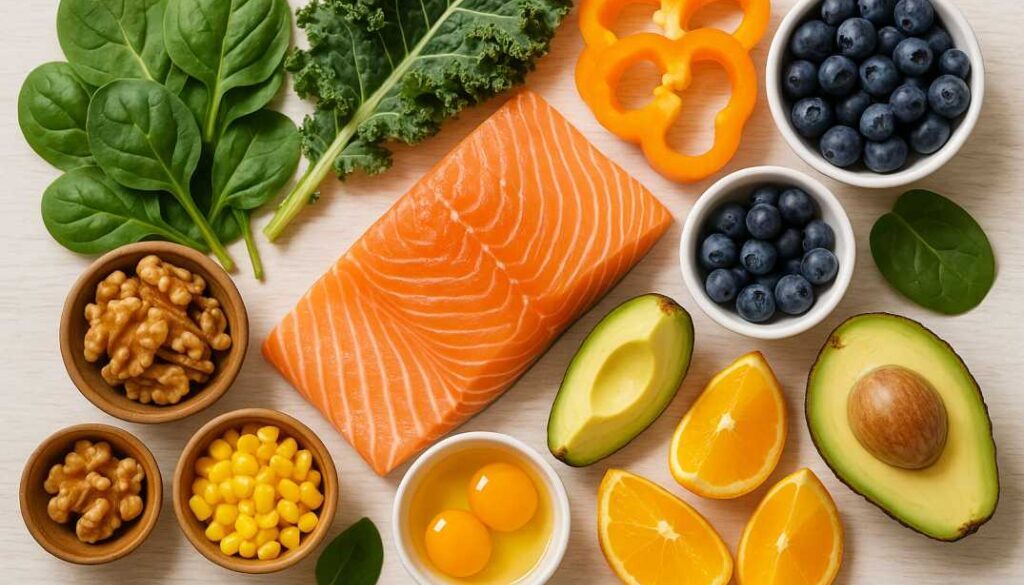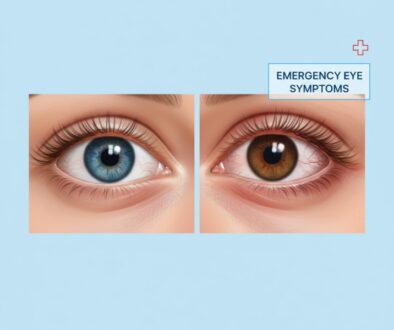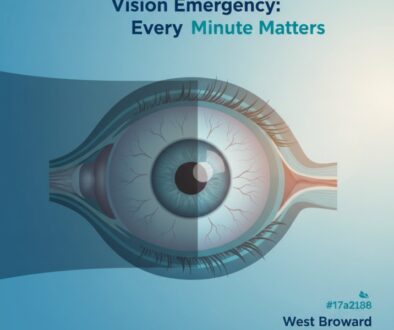Eye Health Nutrition: Best Foods for Vision 2025
Executive Summary: Recent clinical research demonstrates that specific dietary interventions can reduce the risk of vision-threatening conditions by up to 30%. This comprehensive analysis examines peer-reviewed evidence supporting the role of omega-3 fatty acids, lutein, zeaxanthin, and antioxidant vitamins in preventing age-related macular degeneration, cataracts, and dry eye syndrome while supporting optimal visual function throughout the lifespan.
The Clinical Imperative for Ocular Nutrition
The retina represents one of the most metabolically active tissues in the human body, with oxygen consumption rates exceeding those of brain tissue. Current epidemiological data indicate that over 21 million Americans are affected by age-related eye diseases, with digital device usage now averaging 7.4 hours daily among adults—creating unprecedented oxidative stress on ocular tissues.
As leading practitioners at West Broward Eyecare Associates, we have observed a direct correlation between dietary patterns and the progression of vision-threatening conditions across multiple generations of patients. The emerging body of clinical evidence supports a paradigm shift toward preventive nutritional interventions, particularly given the limited therapeutic options available for advanced ocular pathology.
Recent clinical studies provide compelling evidence that specific micronutrients can reduce the risk of age-related macular degeneration by up to 30%, significantly slow cataract progression, and improve symptoms of dry eye syndrome. This represents a substantial advancement in preventive ophthalmology, offering patients evidence-based interventions for conditions that historically had limited treatment options.
Pathophysiological Mechanisms of Ocular Nutrition
Oxidative Stress and Antioxidant Defense Systems
The retinal environment, particularly the macula, exists under conditions of high oxidative stress due to intense light exposure, elevated oxygen consumption, and abundant polyunsaturated fatty acids. This metabolic milieu generates reactive oxygen species (ROS) that can damage photoreceptor cells, retinal pigment epithelium, and choroidal vasculature.
Antioxidant defense mechanisms include both enzymatic (superoxide dismutase, catalase, glutathione peroxidase) and non-enzymatic systems. The latter comprises dietary antioxidants such as vitamins C and E, carotenoids, and trace minerals that function as cofactors for antioxidant enzymes.
Key protective mechanisms include:
- Antioxidant defense: Nutrients like vitamins C and E neutralize damaging free radicals
- Blue light filtering: Lutein and zeaxanthin act as natural sunglasses, filtering harmful blue light
- Anti-inflammatory action: Omega-3 fatty acids reduce inflammation that can damage eye tissues
- Cellular maintenance: Zinc helps transport vitamin A to the retina and supports overall eye structure
Contemporary Clinical Evidence
The MADEOS Trial (2024)
A prospective, randomized, multicenter, double-blind, placebo-controlled study published in Experimental Eye Research demonstrated that eicosapentaenoic acid (EPA)-rich omega-3 supplementation resulted in a statistically significant 6-letter improvement in Early Treatment Diabetic Retinopathy Study (ETDRS) visual acuity in patients with dry age-related macular degeneration over a 24-week intervention period (p=0.003).
Digital Eye Strain Study (2025)
A randomized controlled trial published in Frontiers in Nutrition evaluated 70 participants using electronic screens >6 hours daily. The intervention group receiving 10mg lutein and 2mg zeaxanthin isomers showed significant improvements in Schirmer tear test results (p<0.05), photo-stress recovery time (p<0.01), and tear film break-up time (p<0.05) compared to placebo controls.
Nutritional Genomics Research (2024)
Published in Nutrients, this comprehensive systematic review identified genetic polymorphisms in complement factor H (CFH), APOE, and oxidative stress pathways that modulate individual responses to nutritional interventions, suggesting future personalized approaches to ocular nutrition.
Evidence-Based Nutritional Interventions
Lutein and Zeaxanthin: Macular Pigment Optimization
Lutein and zeaxanthin are hydroxylated carotenoids that selectively accumulate in the macula, forming the macular pigment optical density (MPOD). These xanthophylls function through two primary mechanisms: selective blue light filtration (400-500nm wavelength) and direct antioxidant activity within photoreceptor outer segments.
Clinical Efficacy:
- Macular degeneration risk reduction: 18-25% in high dietary intake groups
- Blue light filtering capacity: 40-90% depending on macular pigment density
- Digital eye strain improvement: Statistically significant in 2025 RCT (n=70)
- Contrast sensitivity enhancement: Demonstrated in multiple controlled trials
Bioavailability Considerations: Lutein bioavailability from food sources ranges from 3-60%, influenced by food matrix, processing methods, and co-consumed lipids. Egg yolk lutein demonstrates superior absorption compared to leafy green sources due to lipid co-localization.
Optimal Dosing Parameters:
- Therapeutic range: 10-20mg lutein, 2-4mg zeaxanthin daily
- Food-based sources: 1 cup cooked spinach provides ~11mg lutein
- Supplemental forms: Free lutein shows enhanced bioavailability over lutein esters
Omega-3 Fatty Acids: Structural and Functional Optimization
Docosahexaenoic acid (DHA) comprises 50-60% of photoreceptor outer segment fatty acids, while eicosapentaenoic acid (EPA) demonstrates potent anti-inflammatory properties through specialized pro-resolving mediator synthesis. Both long-chain omega-3 fatty acids are essential for optimal retinal function and cannot be synthesized de novo by human metabolism.
Therapeutic Mechanisms:
- Membrane fluidity maintenance: DHA incorporation into phospholipid bilayers optimizes rhodopsin function
- Neuroprotective signaling: EPA-derived resolvins and protectins reduce retinal inflammation
- Tear film stabilization: Improved meibomian gland function and reduced evaporative dry eye
- Vascular support: Enhanced retinal blood flow and reduced diabetic retinopathy progression risk
Clinical Outcomes: The 2024 MADEOS trial demonstrated that EPA-rich formulations (3660mg EPA+DHA daily) resulted in:
- Mean visual acuity improvement: 6 ETDRS letters (p=0.003)
- Reduced arachidonic acid/EPA ratio: From 5.84±1.05 to 1.47±0.16 (p=0.002)
- Enhanced subjective visual quality scores at 24-week endpoint
Dietary Sources and Dosing:
- Wild-caught marine species: Salmon (1.8g/100g), mackerel (2.6g/100g), sardines (2.0g/100g)
- Therapeutic supplementation: 1000-3000mg combined EPA/DHA daily
- Alpha-linolenic acid conversion: <5% efficiency to EPA/DHA in humans
Ascorbic Acid (Vitamin C): Aqueous Humor Optimization
Vitamin C concentrations in aqueous humor exceed plasma levels by 15-20 fold, indicating active transport mechanisms and suggesting critical physiological functions. As the primary water-soluble antioxidant in anterior chamber fluid, ascorbic acid protects against UV-induced oxidative damage and maintains lens transparency.
Mechanistic Actions:
- Free radical scavenging in aqueous humor
- Collagen synthesis support for corneal and scleral integrity
- Regeneration of vitamin E from its oxidized forms
- Protection against advanced glycation end-product formation
Clinical Evidence: Epidemiological studies demonstrate inverse correlations between dietary vitamin C intake and cataract risk, with the highest quintile of intake showing 45% reduced risk of posterior subcapsular cataracts compared to the lowest quintile of consumers.
Therapeutic Dosing:
- Dietary sources: 500mg daily achievable through citrus fruits and vegetables
- AREDS2 formulation: 500mg daily (established therapeutic dose)
- Upper tolerance limit: 2000mg daily without adverse effects
Vitamin E: The Fat-Soluble Guardian
Unlike vitamins A and C, which are single compounds, vitamin E is a group of compounds called tocopherols and tocotrienols. These compounds indirectly benefit the eyes by protecting critical fatty acids from oxidation.
Key Benefits:
- Protects cell membranes from oxidative damage
- Works synergistically with vitamin C
- May reduce cataract risk when combined with other antioxidants
- Supports overall retinal health
Excellent Sources:
- Nuts and seeds: Almonds, sunflower seeds, hazelnuts
- Healthy oils: Wheat germ oil, sunflower oil, safflower oil
- Leafy greens: Spinach, Swiss chard
- Avocados: Rich in vitamin E and healthy fats that enhance absorption
Daily Goal: The RDA for vitamin E is 15mg (22 IU) for adults—about one ounce of sunflower seeds or almonds. However, the AREDS2 formula uses 400 IU, which is higher than typical daily needs but has been proven safe for eye health.
Zinc: The Mineral MVP
Zinc plays a vital role in transporting vitamin A from your liver to your retina and helps produce melanin, a protective pigment in your eyes.
Essential Functions:
- Enables night vision
- Supports overall retinal health
- Helps prevent age-related macular degeneration
- Maintains proper immune function in eye tissues
Rich Sources:
- Lean proteins: Grass-fed beef, turkey, chicken
- Seafood: Oysters, crab, lobster
- Plant sources: Pumpkin seeds, chickpeas, lentils
- Dairy: Milk, yogurt, cheese
Daily Goal: 8-11mg for adults (8mg for women, 11mg for men)—found in 3 ounces of lean beef or a handful of pumpkin seeds. Note that the AREDS2 formula contains 80mg, which is much higher than daily nutritional needs but has been proven effective and safe for those with intermediate to advanced macular degeneration.
Anthocyanins: The Purple Powerhouses
These deep purple and blue pigments provide potent antioxidant protection and have shown promise in improving night vision and reducing eye fatigue.
Research-Backed Benefits:
- Improve blood flow to the retina
- Enhance night vision adaptation
- Reduce digital eye strain
- Support overall vascular health in the eyes
Best Sources:
- Berries: Blueberries, blackberries, bilberries
- Purple produce: Purple grapes, eggplant, red cabbage
- Dark cherries: Tart cherries, sweet cherries
Eye-Healthy Meal Planning: Practical Nutrition Guide
The Mediterranean Eye Health Diet
The Mediterranean dietary pattern provides an exceptional foundation for eye health nutrition. Studies consistently show that people following Mediterranean-style eating patterns have significantly lower rates of age-related eye diseases.
Daily Structure:
- Breakfast: Spinach and egg omelet with avocado slices
- Lunch: Salmon salad with mixed greens, bell peppers, and walnuts
- Dinner: Grilled mackerel with steamed broccoli and sweet potato
- Snacks: Blueberries with almonds, orange slices
Sample Weekly Meal Plan
Monday:
- Breakfast: Greek yogurt with berries and chopped walnuts
- Lunch: Kale Caesar salad with grilled chicken
- Dinner: Baked salmon with roasted Brussels sprouts
Tuesday:
- Breakfast: Scrambled eggs with spinach and orange juice
- Lunch: Tuna salad wrap with lots of greens
- Dinner: Turkey and vegetable stir-fry with brown rice
Wednesday:
- Breakfast: Smoothie with spinach, mango, and chia seeds
- Lunch: Lentil soup with a side of steamed broccoli
- Dinner: Grilled sardines with sweet potato fries
Continue this pattern, ensuring each day includes multiple servings of eye-healthy foods from different categories.
Quick and Easy Eye-Healthy Recipes
Vision-Boosting Green Smoothie
- 2 cups fresh spinach
- 1 cup mango chunks
- 1/2 avocado
- 1 tablespoon chia seeds
- 1 cup unsweetened almond milk
- Blend until smooth
Lutein-Rich Salad
- 3 cups mixed greens (spinach, kale, arugula)
- 1 hard-boiled egg, chopped
- 1/4 cup corn kernels
- Orange bell pepper strips
- Handful of walnuts
- Olive oil and lemon dressing
Foods to Limit for Better Eye Health
The Dietary Villains
Certain foods can increase inflammation and oxidative stress, potentially accelerating eye aging and disease progression.
Limit These:
- Processed foods: High in advanced glycation end products (AGEs) that damage retinal blood vessels
- High-sugar foods: Create inflammation and may worsen diabetic retinopathy
- Trans fats: Found in many packaged foods, these promote inflammation
- Excessive omega-6 oils: Corn oil, soybean oil, in large quantities, can be pro-inflammatory
The Glycemic Index Connection
Evidence shows that eating more low-GI foods lowers your risk of developing AMD. Low GI foods include most fruit and vegetables, wholegrain cereals, wholegrain breads, and legumes. High-glycemic foods cause rapid blood sugar spikes that can damage the delicate blood vessels in your eyes over time.
Special Considerations for Different Life Stages
Children and Teens: Building Strong Visual Foundations
Young eyes need specific nutrients for proper development:
- DHA for visual development: Essential during the first few years of life
- Lutein for screen protection: Increasingly important as screen time increases
- Balanced nutrition: Establishing healthy eating patterns early
Family-Friendly Options:
- Scrambled eggs (lutein and protein)
- Fish sticks made from real salmon or cod
- Sweet potato fries (beta-carotene)
- Smoothies with hidden spinach
Adults 40-65: Prevention and Maintenance
This crucial period is when age-related changes begin, making prevention essential:
- Increased antioxidant needs: Higher doses of vitamins C and E
- Omega-3 focus: Regular fish consumption or high-quality supplements
- Blue light protection: Lutein and zeaxanthin become increasingly important
Seniors 65+: Managing Age-Related Changes
Nutritional needs intensify as the risk for eye diseases increases:
- Therapeutic doses: May benefit from AREDS2 formula supplements
- Digestive considerations: Choose easily absorbed forms of nutrients
- Medication interactions: Work with healthcare providers to avoid conflicts
Supplements vs. Whole Foods: Making the Right Choice
When Food Comes First
These findings could suggest that omega-3s are more effective at reducing the risk of age-related eye diseases when you get them through food, instead of a nutritional supplement. Whole foods provide nutrients in their natural matrix, often with better absorption and additional beneficial compounds.
Advantages of Food Sources:
- Better bioavailability
- Synergistic nutrient combinations
- Lower risk of imbalances
- Additional health benefits beyond vision
When Supplements Make Sense
The landmark AREDS and AREDS2 studies demonstrated that specific supplement formulations can reduce the risk of advanced macular degeneration progression by 25% in high-risk individuals.
Consider Supplements If:**
- You have been diagnosed with intermediate or advanced macular degeneration (as determined by your eye care professional)
- Dietary intake is consistently inadequate despite efforts to improve it
- You have specific absorption issues or medical conditions affecting nutrient uptake
- Your eye care professional specifically recommends them based on your individual risk factors
Important Note: The National Eye Institute recommends AREDS2 supplements ONLY for people with intermediate to advanced AMD. For individuals with early-stage AMD or healthy eyes, studies have not shown a significant benefit from these high-dose supplements.
AREDS2 Formula Components (Official National Eye Institute Recommendations):
- Vitamin C: 500mg
- Vitamin E: 400 IU
- Lutein: 10mg
- Zeaxanthin: 2mg
- Zinc: 80mg
- Copper: 2mg (as cupric oxide, to prevent zinc-induced copper deficiency)
Beyond Nutrition: Complementary Eye Health Strategies
The 20-20-20 Rule
For those spending significant time on screens, follow the 20-20-20 rule: every 20 minutes, look at something 20 feet away for 20 seconds. Digital screens emit blue light that can strain your eyes and potentially damage retinal cells over time.
UV Protection
Always wear sunglasses that block 100% of UVA and UVB rays when outdoors. UV radiation can accelerate cataract formation and contribute to macular degeneration.
Regular Eye Exams
Nutrition supports eye health, but it cannot replace professional eye care. Regular comprehensive eye exams can detect problems early when they’re most treatable.
Smoking Cessation
Smoking is the single most modifiable risk factor for macular degeneration and cataracts. If you smoke, quitting is the most important step you can take for your vision.
When to Seek Professional Guidance
Schedule an Eye Exam If You Notice:
- Sudden changes in vision
- Flashing lights or new floaters
- Loss of peripheral vision
- Difficulty seeing at night
- Persistent eye pain or discomfort
- Changes in color perception
Working with Your Eye Care Team
At West Broward Eyecare Associates, we believe in a comprehensive approach to eye health that includes both professional care and lifestyle guidance. Our experienced team can help you:
- Assess your individual risk factors
- Develop a personalized nutrition plan
- Monitor changes over time
- Coordinate with other healthcare providers
- Recommend appropriate supplements if needed
Scientific References and Additional Resources
The information in this article is based on peer-reviewed research and authoritative medical sources. For readers interested in exploring the scientific foundation behind these recommendations, here are three key resources that were instrumental in developing this content:
1. National Eye Institute – AREDS/AREDS2 Clinical Trials
Source: National Institutes of Health, National Eye Institute
Link: https://www.nei.nih.gov/research/clinical-trials/age-related-eye-disease-studies-aredsareds2/about-areds-and-areds2
Key Finding: The landmark AREDS and AREDS2 studies demonstrated that specific nutrient combinations can reduce the risk of advanced AMD progression by 25% and vision loss by 19% in high-risk individuals. This government resource provides the official recommendations for supplement formulations and eligibility criteria.
2. Frontiers in Nutrition – Lutein/Zeaxanthin Screen Study (2025)
Source: Lopresti AL and Smith SJ, Frontiers in Nutrition, January 2025
Link: https://www.frontiersin.org/journals/nutrition/articles/10.3389/fnut.2025.1522302/full
Key Finding: This recent randomized, double-blind, placebo-controlled trial found significant improvements in dry eye symptoms and visual health measures after 6 months of lutein and zeaxanthin supplementation in people who used electronic screens for more than 6 hours daily.
3. MADEOS Study – EPA-Rich Omega-3 for Macular Degeneration (2024)
Source: ScienceDirect, Clinical research study
Link: https://www.sciencedirect.com/science/article/pii/S2213434424000264
Key Finding: This prospective, randomized, multicenter study showed that EPA-rich omega-3 supplementation led to a 6-letter improvement in visual acuity for patients with dry AMD and Stargardt disease over 24 weeks, offering hope for therapeutic nutrition approaches.
Disclaimer: While these studies provide valuable scientific evidence, individual results may vary. This article is for educational purposes only and should not replace professional medical advice. Always consult with your eye care professional before making significant dietary changes or starting new supplements, especially if you have existing eye conditions or take medications.
Summary: Your Action Plan for Better Eye Health Nutrition
The connection between what you eat and your vision health is undeniable. Here’s your practical action plan:
Start This Week:
- Include omega-3 rich fish 2-3 times per week (salmon, mackerel, sardines)
- Add dark leafy greens to one meal daily (spinach, kale, collard greens)
- Choose colorful vegetables and fruits rich in antioxidants
- Limit processed foods and high-sugar items that promote inflammation
For Long-Term Vision Protection:
- Schedule regular comprehensive eye exams with qualified professionals
- Consider AREDS2 supplements if diagnosed with intermediate macular degeneration
- Maintain healthy blood pressure and blood sugar levels
- Protect eyes from UV radiation with quality sunglasses
Key Takeaways for Optimal Eye Health Nutrition:
- Foods for vision work best when eaten consistently over time
- Whole foods provide better absorption than most supplements
- Early prevention is more effective than late-stage treatment
- Professional guidance ensures personalized, safe approaches
For personalized guidance on nutrition and eye health, schedule a comprehensive eye exam with our experienced team at West Broward Eyecare Associates. We’re proud to serve the families of Tamarac and surrounding communities with compassionate, expert eye care that combines the latest technology with the personal attention your family deserves.
FAQs
-
Leafy greens, carrots, eggs, fatty fish, and nuts provide essential nutrients like lutein, zeaxanthin, vitamin A, and omega-3 fatty acids.




